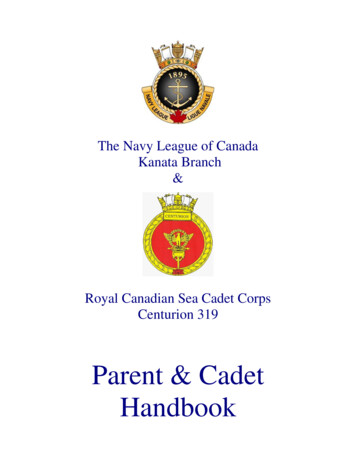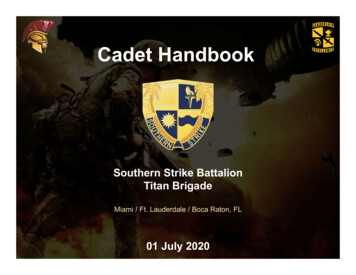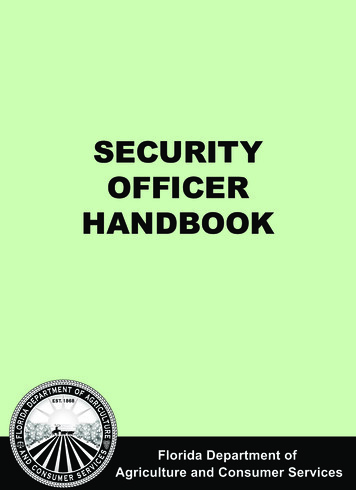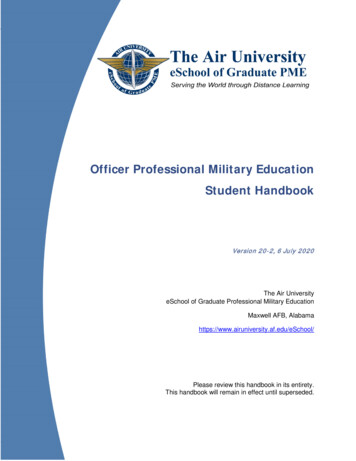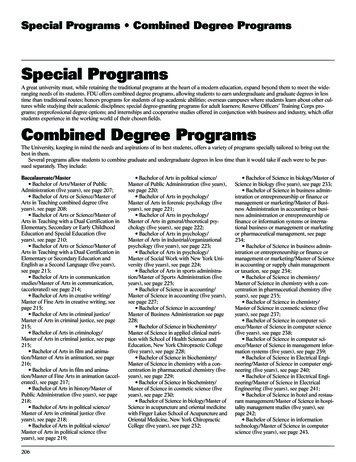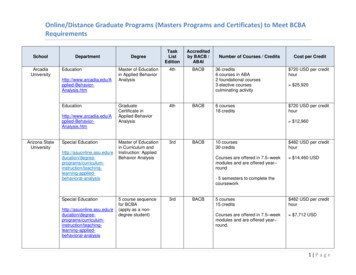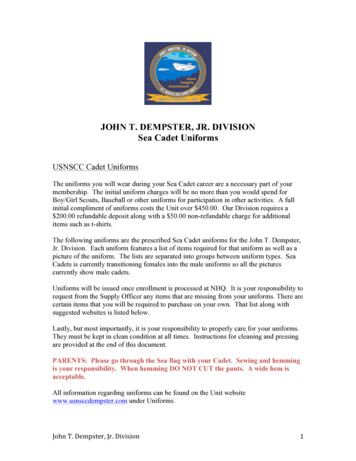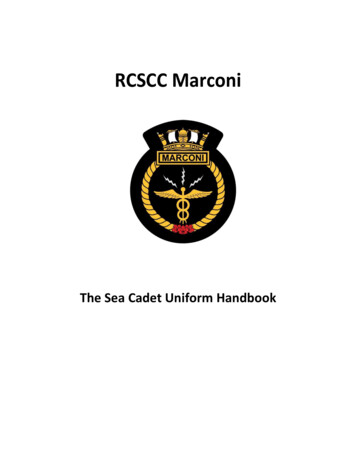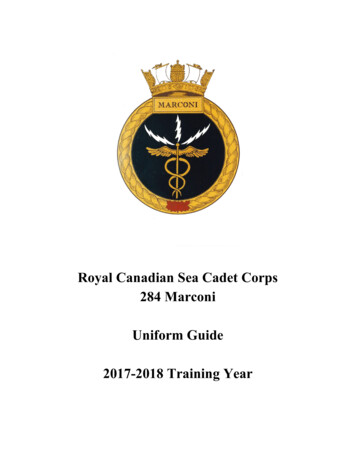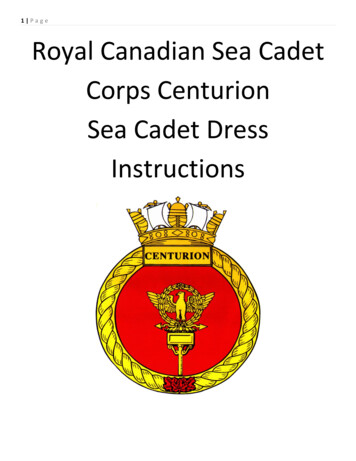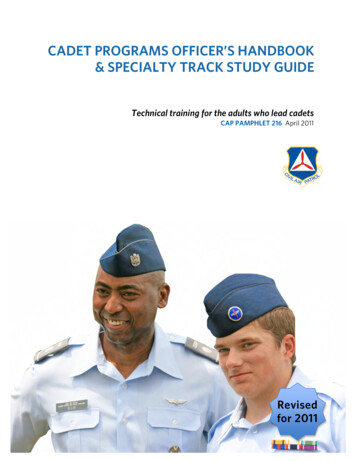
Transcription
CADET PROGRAMS OFFICER’S HANDBOOK& SPECIALTY TRACK STUDY GUIDETechnical training for the adults who lead cadetsCAP PAMPHLET 216 April 2011Revisedfor 2011
CADET PROGRAMS OFFICER’S HANDBOOK& SPECIALTY TRACK STUDY GUIDECAP Pamphlet 216This handbook explains how adults can get started helping cadets. It is also a guide to theCadet Programs Officer Specialty Track. The specialty track is a means for learning about theCadet Program from the adult point of view and is a self-paced, self-study program. Its overallgoal is to prepare senior members to lead cadets and manage cadet programs. Specialtytracks are governed by CAPR 50-17, Senior Member Professional Development Program.NEW IN THIS EDITIONThis guide supersedes CAPP 216 dated April 2009. What’s different about this edition is that: Reading lists have been updated to reflect new resources published since 2009 References to CAPR 52-16, Cadet Program Management, have been updated to correspond to thatregulation’s most current version. The testing officer’s position description has been adjusted to reflect CAP’s emphasis on onlineachievement testing.All told, perhaps 5% of the text has changed, compared with the 2009 edition. No substantive changeshave been made to the specialty track’s overall requirements.TABLE OF CONTENTSPart 1:Introduction to the Specialty Track1Part 2:Getting Started as a Cadet Programs Officer3Part 3:Instructions for Students11Part 4:Instructions for Trainers & Commanders12Part 5:Technician Rating13Part 6:Senior Rating16Part 7:Master Rating20Part 8:Position Descriptions23Part 9:Annual Calendar of Major Cadet Program Events33
Part 1 INTRODUCTION TO THE SPECIALTY TRACKThe goal of the Cadet Programs Officer Specialty Track program is to prepare senior members to leadcadets and manage cadet programs. The training program focuses on squadron-level cadet activities,but topics relating to higher echelons are also addressed.1.1OVERVIEW OF THE TRAINING PROGRAMThis specialty track is divided into three ratings: technician, senior, and master. Students enrolled inthe program complete each rating in succession and at their own pace. Students should train under theguidance of a mentor who has attained a higher rating in the specialty track, but if necessary, studentsmay complete the training independently.Training Requirements. To earn specialty track ratings, students must fulfill knowledge and servicerequirements and participate in a summary conversation with their trainer or commander.Knowledge Requirements are objectives describing what each student is expected to know beforeattaining the rating. An online test is the primary method by which students demonstrate theyunderstand this material.Service Requirements are objectives describing what each student is expected to completethrough active participation before attaining the rating.The Summary Conversation serves as a capstone event where students discuss what they learnedwith their trainer. It is a mentoring opportunity, not an oral exam. Trainers also use the meeting toverify that the student fulfilled all service requirements.Reading Lists. Reading lists are a starting point for the students’ training and have been included foreach rating. All publications are available on-line. Because CAP publications are always evolving,references might not be completely accurate. Use common sense and good judgment to research theanswers to the knowledge requirements.Duty Assignments. While not limiting the role students may take as Cadet Programs Officers, it issuggested that their level of responsibility begin modestly and increase as they advance (see Figure 1).RATINGTRAINING TOPICSTechnicianSUGGESTED DUTY ASSIGNMENTDURING TRAININGUPON COMPLETIONFundamental Cadet ProgramsGoals, Polices & ProceduresAssistant Leadership, Aerospace,Activities, or Testing OfficerLeadership, Aerospace, Activities,or Testing OfficerSeniorSquadron OperationsLeadership, Aerospace, Activitiesor Testing OfficerSquadron Deputy CommanderMasterWing OperationsSquadron Deputy CommanderSquadron Commander orWing Director of Cadet ProgramsFigure 1. Training topics and suggested duty assignments1
1.2ADVANCING IN THE SPECIALTY TRACKRequesting a New Rating. AfterLEADERSHIPCADET PROGRAMSRATINGparticipating in the summaryRIBBONSPECIALTY BADGEconversation and having the trainerTechnicianBasic RibbonBlue Staror commander confirm that allservice requirements have beenSeniorBronze StarBronze Starmet, the students work with theirMasterSilver StarSilver Startrainer or unit professionaldevelopment officer to request aFigure 2. Awards in the Cadet Programs Officer Specialty Tracknew rating through E-Services. Therating becomes official when thecommander (or designee) approves it in E-Services. Alternatively, commanders may approve therating by updating and signing the hard copy Professional Development Report and sending it toMembership Services at National Headquarters.Awards. Upon earning their new rating, members qualify for the Leadership Ribbon, Cadet ProgramsSpecialty Badge, and a certificate available in the Cadet Library at the CAP web site (see Figure 2). Formore details, see CAPR 39-3, Award of CAP Medals, Ribbons, and Certificates, and CAPM 39-1, CAPUniform Manual.1.3FORMER CADETS AS CADET PROGRAMS OFFICERSChanging Status. When former cadets choose to turn senior and become Cadet Programs Officers,they bring with them tremendous personal experience and an innate understanding of what cadetswant from their program. But being a cadet and providing adult leadership to cadets are two entirelydifferent skill sets. There is a transition to make. Some of the topics former cadets will need to acquaintthemselves with include: Partnering with parentsHandling sensitive personnel issuesSafeguarding CAP resourcesProtecting cadets’ welfareDeveloping relationships with community leadersParticipating in this specialty track, especially the Training Leaders of Cadets course, and beingmentored by an experienced Cadet Programs Officer can help former cadets succeed as adult leaders.Advanced Ratings. In recognition of their experience, former cadets who earned the Earhart Award areeligible to receive the Technician Rating in the Cadet Programs Specialty Track upon becoming asenior member. Likewise, former cadets who earned the Spaatz Award are eligible to receive theSenior Rating. These advanced ratings are awarded on an individual basis. Former cadets who qualifyfor these awards should submit a written request, approved by their unit commander, to HQ CAP/DP.2
Part 2GETTING STARTED AS A CADET PROGRAMS OFFICERSurvey after survey, cadets say that the #1 factor affecting the their cadet experience is the quality oftheir adult leadership. No cadet unit can succeed without outstanding adult leadership from a team ofCadet Programs Officers. Their over-arching responsibility is to create the conditions necessary foryouth to succeed as CAP cadets.2.1. STAFF POSITIONS“Cadet Programs Officer” is an umbrella term referring to any senior member whose main focus iscadets. It is not a formal duty title. Most of the individuals serving in the roles below considerthemselves to be Cadet Programs Officers. See Part 8 for suggested position descriptions.SquadronCommanderDeputy Commanderor Deputy Commander for CadetsLeadership OfficerAerospace Education OfficerActivities OfficerCharacter Development Instructor or ChaplainDrug Demand Reduction OfficerTesting OfficerGroup, Wing, RegionDeputy Chief of Staff, Cadet Programs (Regions)Director of Cadet ProgramsCadet Programs Development OfficerCadet Programs Special Activities OfficerDrug Demand Reduction AdministratorFigure 3 (on the following page) illustrates the breadth of the adult leaders’ responsibilities in theCadet Program. Because local needs will vary, the diagram is not intended to be definitive.2.2TEN WAYS TO HELP YOUSELF GET STARTED AS A CADET PROGRAMS OFFICER1.Read the Regulation. This should be your starting point. Chapters 1 through 5 are especiallyrelevant to your efforts as a squadron-level Cadet Programs Officer.2.Training Leaders of Cadets. TLC is a two-day course and is the premiere venue for learningabout Cadet Programs. Attend TLC at your earliest opportunity, and in the meantime, browse thecourse materials on your own at capmembers.com/tlc.3.Study Guide. Your specialty track study guide (i.e.: this pamphlet) is a plan for on-the-jobtraining that you can lead yourself through on your own or under a mentor’s guidance.4.Inspection Guide. Wings inspect squadrons every few years. Even if your unit is not due for aninspection, reviewing the inspection guide is a good way to learn which areas of your job areconsidered most important. Also see if your predecessor left a continuity book containing activityplans, points of contact, previous budgets, etc.5.Mentor. A mentor is an invaluable teacher, coach, and sounding board. If your commanderhasn’t appointed one for you, ask.3
6.Wing & CAP-USAF Staffs. Your counterpart on the wing staff can be a great mentor. If you livein a big state, getting together may be impractical, but help is always available, if only from a distance.Likewise, our CAP-USAF partners occasionally visit squadrons. You are encouraged to solicit their advice.7.Neighboring Squadrons. If your wing headquarters is not nearby, try working with a neighboring squadron. Maybe your counterpart in that unit can give you some pointers about your job.8.The Cadet Corps. More than one new Cadet Programs Officer has been helped by an experiencedcadet. Cadet officers are often good sources for learning the basics of what goes on during cadetactivities, what textbooks cadets study, and how cadets advance in their program.9.Knowledgebase. The Knowledgebase at the CAP web site is an interactive encyclopedia. Ifyou’re new to a staff job, try browsing its entries on your staff area.10.Webpages. Of course, you’ll want to browse the Cadet Programs section on the CAP web site.Figure 3. Cadet Programs Officers: Common Task AreasThis diagram is for illustration purposes only; it is not definitive4
2.3THE CADET PROGRAM OFFICER’S FOUR TOP RESOURCESEspecially to a newcomer, the Cadet Program may seem to be a complex new universe. To learn aboutthe role of the Cadet Programs Officer, where do you start? Here’s an overview of four key resources.CAPR 52-16, Cadet Program ManagementCadet Web SiteThe cadet regulation is your primary source forauthoritative guidance on the Cadet Program.Chapters 1 through 5 are the most relevant toeveryday cadet life. Download the regulation atcapmembers.com/library.The cadet web site, capmembers.com/cadets, isthe Cadet Program Officer’s source for officialnews and announcements via the Cadet Blog, aportal to all cadet publications, a calendar ofupcoming cadet activities, and more.Cadet Programs Resource & Planning GuideTraining Leaders of CadetsTo help Cadet Programs Officers build successfulcadet squadrons, CAP offers textbooks, handbooks,activity guides, lesson plans, and more. TheResource & Planning Guide is a catalog of thecurriculum tools and support programs availablefrom National Headquarters. Download the guideat capmembers.com/library.The TLC course is the premiere venue for CadetPrograms Officers to become better mentors ofcadets and more effective managers of cadetsquadrons. TLC is a two-day course hosted bywing or group headquarters. New Cadet ProgramsOfficers can gain much by browsing the materialson their own at capmembers.com/tlc.5
2.4 THE FIVE KEY TRAITS OF CADET LIFEThe Cadet Program offers youth opportunities to participate in a wealth of activities: orientationflights, drill and ceremonies, bivouacs, field trips and tours, and more. While the menu of opportunitiesis diverse, there are five key traits that Cadet Program Officers should incorporate into every activity.Uniform: CAP promotesteamwork and high standardsof personal conduct bygranting cadets the privilegeof wearing an Air Force-styleuniform. The uniform, and therelated tradition of renderingmilitary customs and courtesies, distinguishescadets from ordinary youth. These militaryaspects of cadet life motivate cadets. Everyactivity should allow cadets to wear theiruniform.Aerospace Theme: CAPmembers hold in common alove of flying. Aviation is thethread that runs through allthree CAP missions. Ouraffiliation with the Air Forceunderscores our identity asan air-minded organization. With a littleimagination, even fitness and characteractivities can be shown to have an aerospaceconnection. Every activity should further thecadets’ enthusiasm for aerospace, as“aerospace” is broadly understood.Opportunity to Lead: CAPdevelops leadership skills incadets by giving themopportunities to lead. Thisincludes planning events,making decisions, andteaching and mentoring juniorcadets, depending on how far they haveadvanced in the program. The cadets’ gradestructure and military-style chain of commandreinforces this leadership concept. Everyactivity should allow cadets opportunities tolead, under senior supervision.Challenge: CAP challengesyouth. It might be thephysical challenge ofconquering an obstaclecourse, an academicchallenge to masteraerospace and leadershipconcepts, a moral challenge to live the CoreValues, or a personal challenge to know oneselfbetter and gain self-confidence. Because ofthese challenges, the Cadet Program is foryoung adults, not children. Every activity shouldchallenge cadets in one way or another.Fun: CAP is supposed to be fun. Cadet life is marked by new friends andgreat opportunities. The cadets who work hard in CAP reap the mostbenefits, but the program ought not be another form of school – it needsto be fun. Proper adult supervision, a pro-safety attitude, and teamworkbuilt around mutual respect keep the cadet experience enjoyable. Everyactivity should be fun, for cadets and their adult leaders alike.6
2.5TEN KEYS TO A SUCCESSFUL SQUADRONPicture a handful of CAP’s best Cadet Programs Officers getti
& SPECIALTY TRACK STUDY GUIDE CAP Pamphlet 216 This handbook explains how adults can get started helping cadets. It is also a guide to the Cadet Programs Officer Specialty Track. The specialty track is a means for learning about the Cadet Program from the adult point of view and is a self-paced, self-study program. Its overall goal is to prepare senior members to lead cadets and manage cadet .
